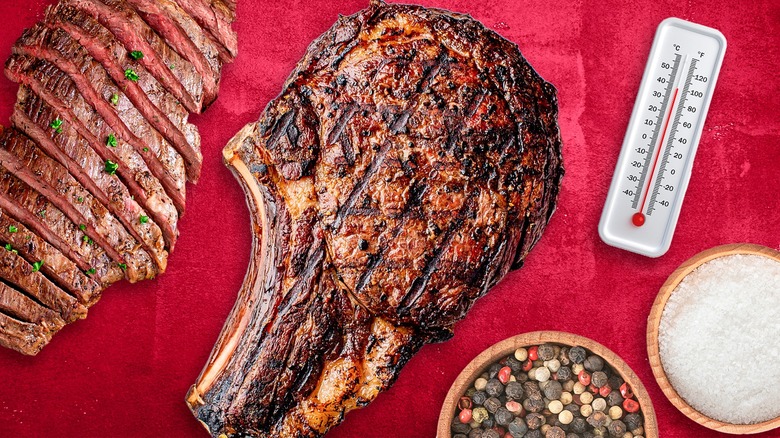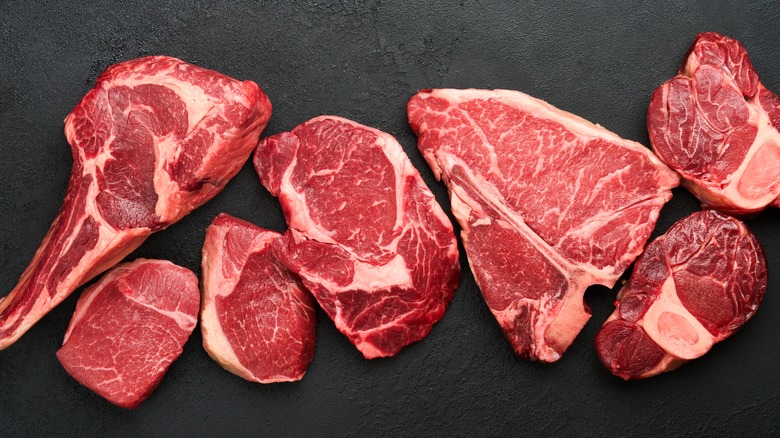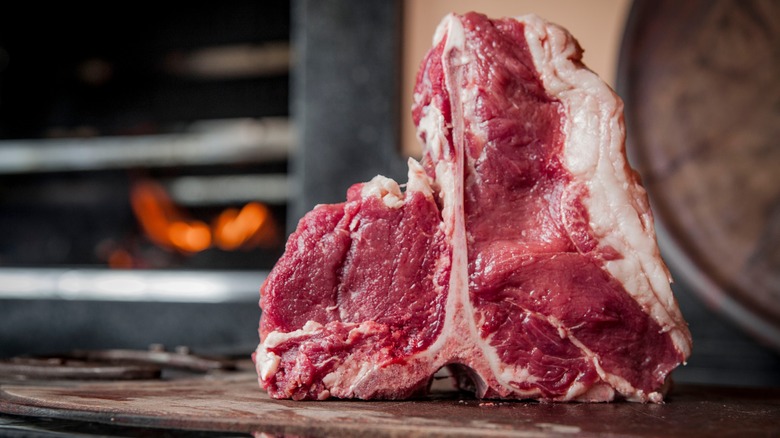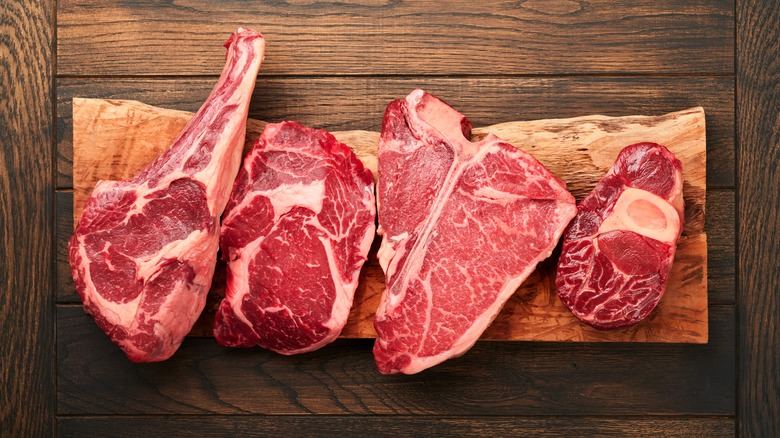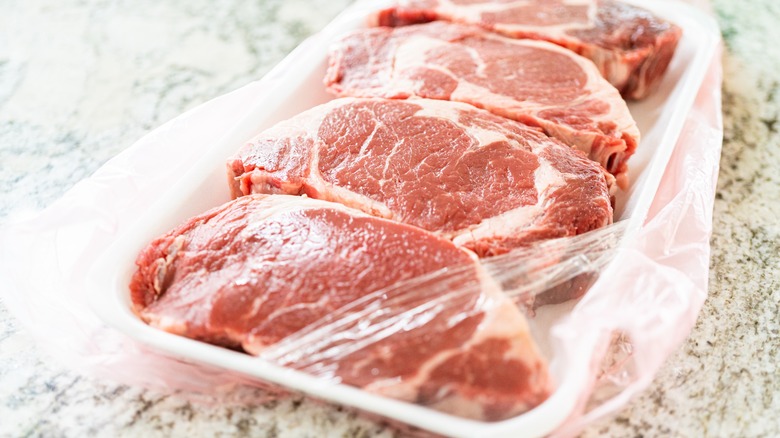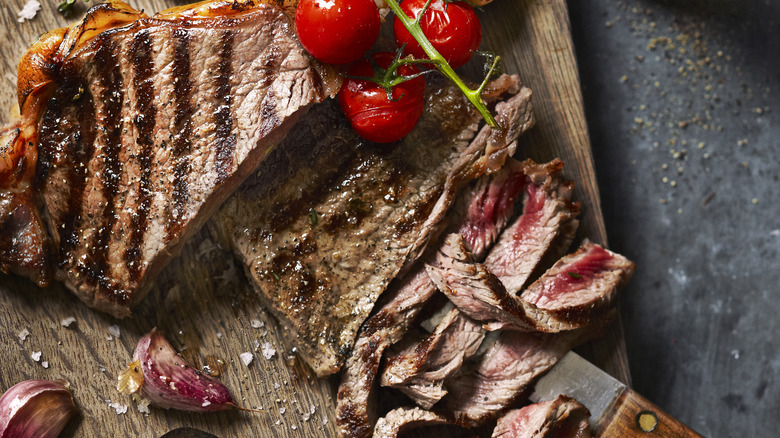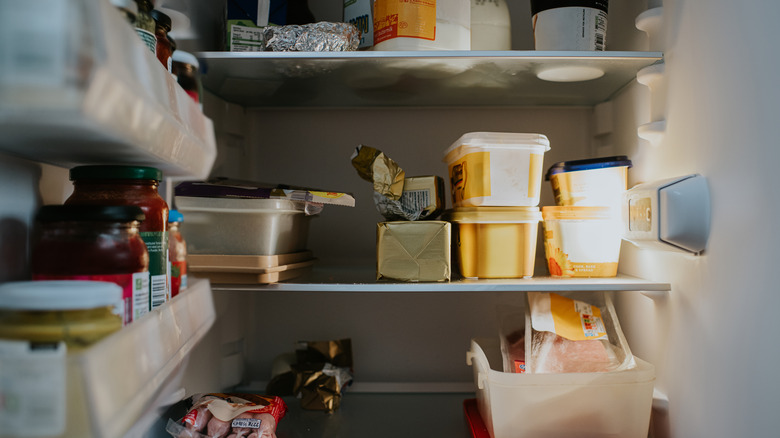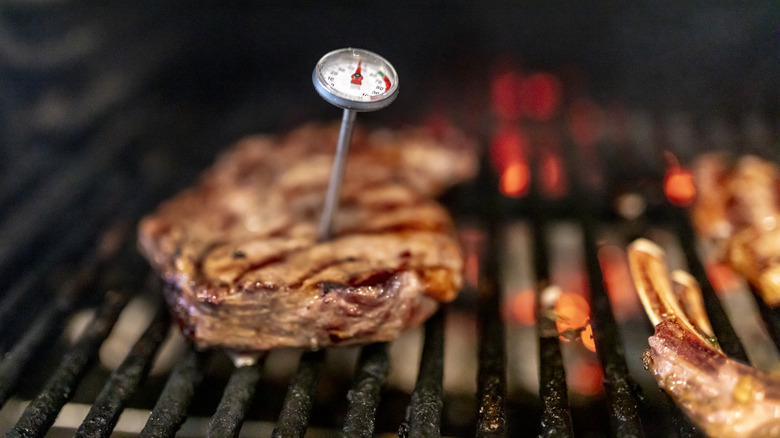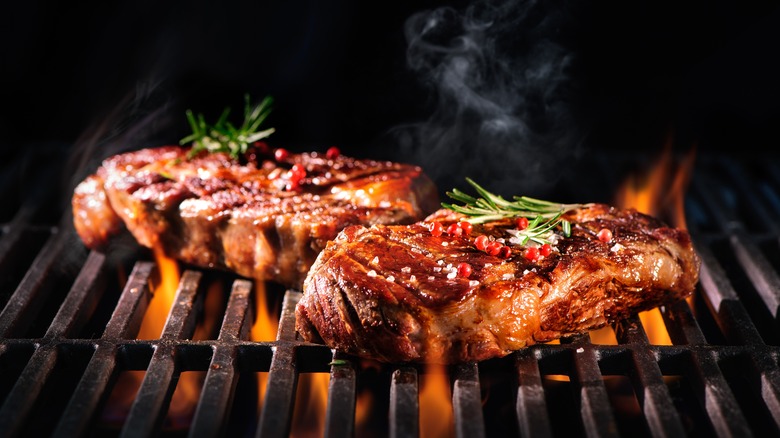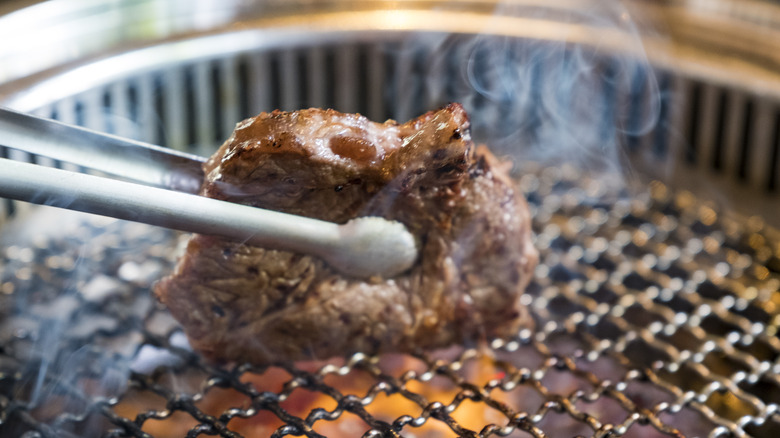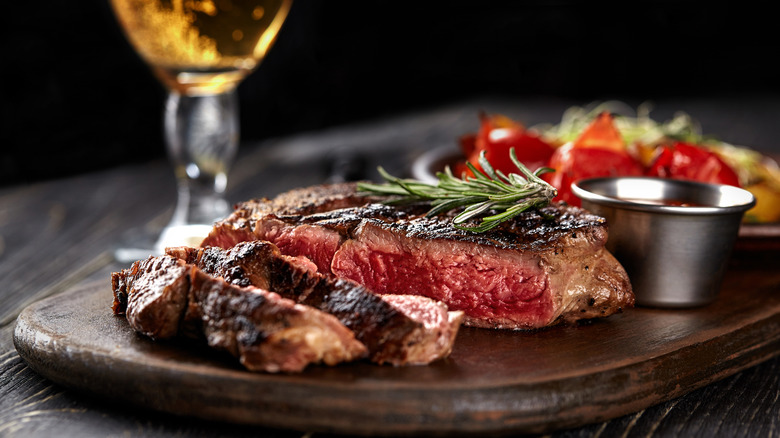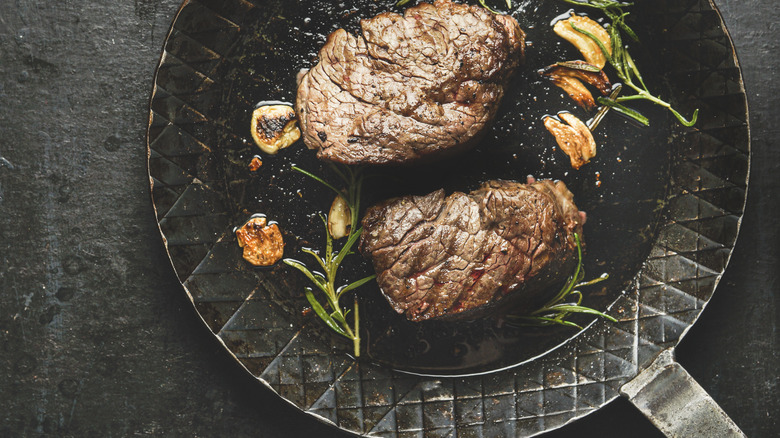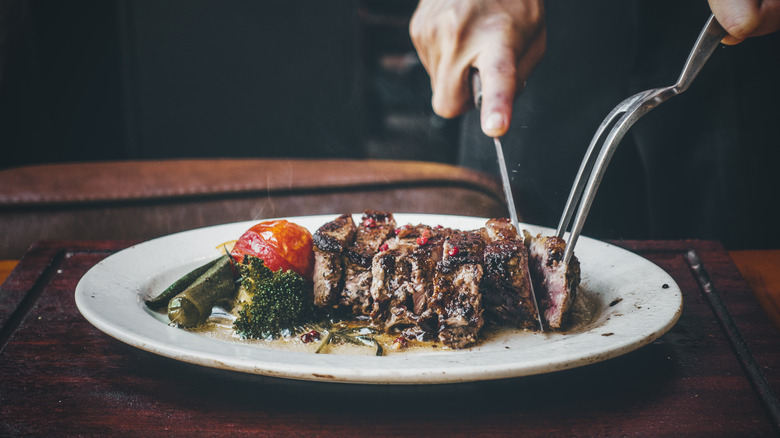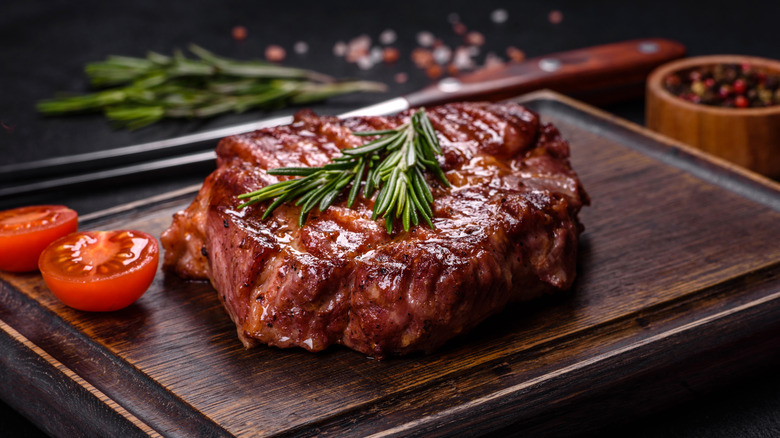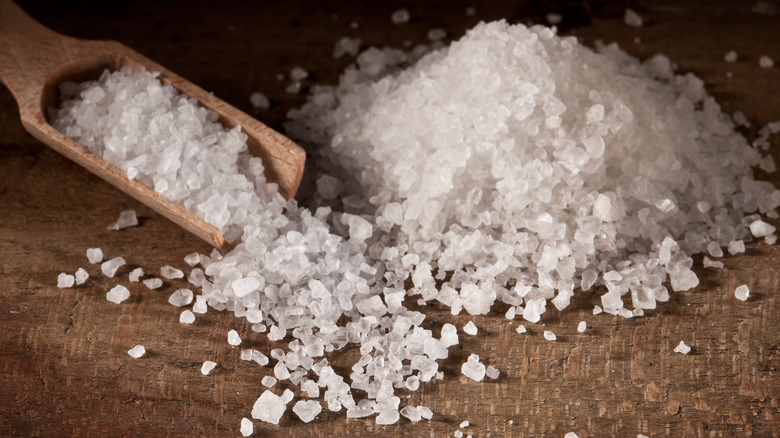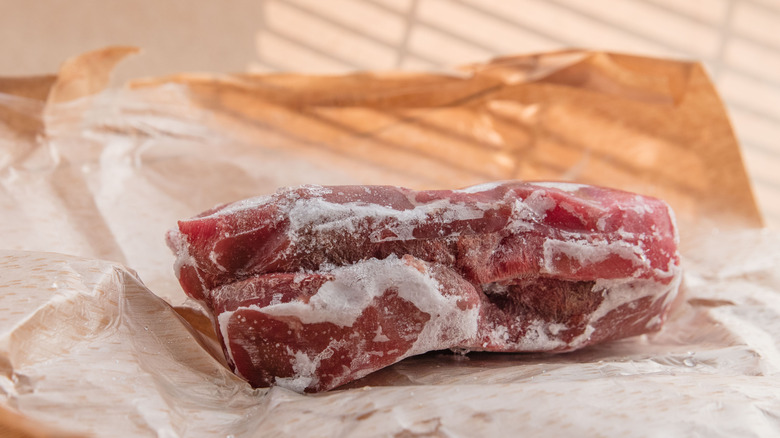15 Common Mistakes That Are Ruining Your Grilled Steak
From outdoor summer get-togethers to a gourmet dinner date classic, grilled steaks are a popular choice for good reason. When done correctly, a good grilled steak is rich, tender, juicy, packed with flavor and very hard to beat. What initially seems like a quick and easy dish to throw together, however, can quickly get overwhelming when you factor in internal temperature, a fairly long and finicky preparation and cooking process, and the vast array of cuts available.
From choosing the right cut of meat and storing it properly to seasoning it well and letting it rest after cooking, every step of grilling a steak can make or break the dish. Something as simple as opting for the wrong thickness is just one of many easy mistakes that can make your grilled steak tough and bland instead of tender and tasty. Don't fall victim to these mis-steaks.
Understanding the techniques behind preparing and cooking a prime grilled steak will help to avoid these common grilled steak errors and ensure that every bite bursts with flavor. Follow these expert tips and techniques and you'll be eating succulent, restaurant-level steaks from home that rival your favorite steakhouse.
1. Buying a steak without marbling
When it comes to grilling steak, choosing the right cut of meat is key to a high-quality end product that will have your tastebuds hankering for more. There are four factors to consider when selecting your steak, according to Andy Bowler, Executive Chef and Founder at Indulge Dining: marbling, thickness, bones and your personal preference. Perhaps the biggest defining factor of the perfect grilling steak is whether or not it has marbling.
Marbling is the term for the white strands embedded in the muscle of red meat. "Marbling adds a lot of flavor and when it's cooked it renders out so it adds quite a lot of tenderness to the steak," said Bowler. Bowler's choice when it comes to steak cuts is ribeye because it tends to be naturally well-marbled with a good ratio of fat to meat, making for the ideal balance of juiciness and tenderness.
It's worth keeping in mind that your cooking technique to render down the fat may vary depending on the cut of meat. If you've opted for a steak with a piece of fat around one side, start with that side on the grill to help melt that fat into the meat.
2. Choosing a thin steak
After marbling, you need to think about the thickness of your steak when looking for the perfect one to grill. Part of the beauty in a quality grilled steak is the ability to customize the cook on it to your preference, and that demands a decent thickness.
"You want steaks that are at least 1.5 inch thick so you can get a nice cook on it, because without that it's either cooked or it's not," explained Andy Bowler. If you get a steak with a good thickness you have more control over how far the heat can permeate the meat and cook it. Essentially, you can cook your steak perfectly every time, provided you watch your meat thermometer.
Using a thicker steak also means you can achieve a good sear on the outside of it with little risk of overdoing the middle. Browning your steak adds flavor, and to do that you need to give it enough time in contact with the grill surface to trigger the Maillard reaction. With a thick steak, the end result is a nicely brown exterior and a tender, juicy center.
3. Grilling a boneless steak
Bones are brimming with flavorful goodness, which is precisely why stews and stocks made with bones have such depth of flavor. Cooking steak on the bone tends to add flavor, according to Andy Bowler. During the cooking process, bone marrow (which is packed with rich umami flavor) is released from inside the bone into the muscle, making for a more tasty final product. If bones don't bother you and you're after a scrumptious, succulent grilled steak, choosing a cut on the bone is a no-brainer.
If you don't enjoy meat on the bone, don't worry — you're not doomed to a life of eating inferior steak. At the end of the day, it all comes down to personal preference. Whether you prefer your grilled steak without bones, or you prefer leaner cuts of meat without marbling there's no shame in that, and the perfect steak is however you like it. The important thing is to choose good quality. "Buy the best steak that you can afford," said Bowler.
4. Cooking straight from the fridge
One of the most common mistakes when making grilled steak is taking it out the fridge and putting it on the grill straight away. The problem is, cold steak won't cook evenly and you'll notice a gray band in the middle when you cut into it instead of a beautiful, gradual color change. Cooking fridge-cold steak also won't give you a tender end product. The sudden temperature change will cause the meat fibers to tense up, resulting in a tough texture. "Essentially, if you're cooking cold meat, as soon as you apply it to the grill, the heat can't go through the steak," explained Andy Bowler. "It just hits a brick wall of cold, so it can't permeate the meat."
Bowler says to make sure your steak is out of the fridge for at least 45 minutes before you grill it. It may seem like yet another important step in an overly finicky recipe, but don't view this step as an inconvenience. Waiting for the meat to warm up is also the ideal time to season or marinate it, giving it time to really absorb all the flavor.
5. Cross contaminating the meat
Cooking and preparation aren't the only factors that could ruin your grilled steak. Culinary preferences aside, nothing ruins a dish like food poisoning. Raw and undercooked beef can harbor harmful bacteria including salmonella and E. coli, which can cause an upset stomach up to a week after ingestion. If other foods in your kitchen get into contact with raw beef or its juices, you can get sick from those foods, too.
Luckily, cross-contamination is as easy as keeping meat separate. Using designated utensils during preparation, such as a separate cutting board, for handling raw and rare meat can help reduce the risk of cross contamination. Sanitizing items before and after use is essential as well.
Caring for the meat correctly is just one way to ensure you prepare it without cross-contaminating; other hygiene is just as important. Washing your hands before and after handling raw meat is crucial, as is thoroughly washing your kitchen countertops when you're done.
6. Storing your steak incorrectly
Along with cross contamination, storing your raw ingredients correctly is a huge contributing factor for safe steak. Ensure your refrigerator runs at the ideal fridge temperatures (preferably at or below 40 F) and store your steak in the correct region of the fridge — away from fresh produce and dairy products and towards the bottom where it's coldest.
The U.S. Food and Drug Administration notes that refrigeration can help prevent and slow the growth of harmful bacteria on food. For this reason, it's important that your steak isn't out of the fridge for longer than it needs to be.
Refrigerating your steak in an airtight container or in airtight packaging will keep excess moisture out, reducing the risk of bacterial growth and preserving the quality of your steak. Ultimately, fresh steak is best both in terms of quality and food safety, so ensure you use your steak within a few days. Otherwise, freezing it is your best option for longer term preservation.
7. Missing the right internal temperature
From rare to well done, the perfect steak is however you like it. According to Andy Bowler, who has years of experience working at Michelin-starred restaurants, a meat thermometer is your best bet at a perfectly done steak. An accurate number ensures your steak is cooked to the right level, so an accurate meat thermometer is a kitchen gadget well worth the investment.
Knowing your steak temperatures is key to making the perfect grilled steak. A rare steak has an internal temperature around 125-130 F after resting; medium rare is between 130-140 F; medium is between 140-150 F; medium-well is between 150-160; F and well done is over 160 F.
To get an accurate reading on your meat thermometer, stick the probe into the thickest part of the meat, away from any bone or fat. Don't leave your steak cooking until it's reached your desired temperature — it will continue to cook off of the heat when it's resting. Instead, take it off the grill when it's about 50 F away from your target internal temperature.
8. Not pre-heating the grill
Preheating the grill is important for a good quality grilled steak for a number of reasons. It helps ensure you get an even cook, it prevents the meat from sticking to the grill, and it makes for a good sear. Caramelizing or browning your steak amps up the flavor and you won't get any caramelization on a cold grill.
Grilling is best done at a high heat, and there's a simple way to tell if your grill is hot enough. Hold your hand five inches over the grill surface and count — it needs to be too hot to keep your hand there for longer than 2-4 seconds. If your grill has a thermometer built into its lid, the ideal cooking temperature is between 450-550 F.
Every grill is different, but how you heat the grill dictates how long it needs to come up to a good cooking temperature. Andy Bowler says that if you're grilling over wood or charcoal, be sure to give the grill a few hours, whereas a gas grill can be ready after 25 minutes of heating. Even then, every individual grill differs, so it may take some practice to figure out how much time your grill needs to heat up.
9. Skipping the searing step
On the topic of caramelizing, you may not be searing your grilled steak for long enough. "Don't be afraid to leave it on for a good amount of time before you turn it," said Andy Bowler. Searing your steak properly gives you caramelization. Good caramelization equates to both optimal flavor and ideal color, key elements for restaurant-quality grilled steak. Don't shy away from searing it for longer than usual. "Especially if you're using sea salt," said Bowler. "You'll get this really lovely crust on it which is what you're aiming for." A good quality sear also means you get those beautiful grill marks on the meat.
If you're concerned about getting too much caramelization on the meat and your steak is taking a turn for a darker black color rather than a hearty brown, simply move it to a colder part of the grill. Cooking over indirect heat after searing is a great way to allow your steak to continue cooking up to your desired internal temperature without exposing it to burning flames. The result is a perfectly cooked center without compromising on a beautifully seared exterior.
10. Storing leftovers incorrectly
Grilled steak is a dish best served fresh, but if you find you have enough for later, you need to ensure you store it properly. Storing your leftover steak correctly is important both for food safety and for preserving quality.
You want to cool your leftovers as fast as possible. As long as your steak isn't refrigerated, any bacteria in it can survive and multiply. Per the FDA, perishable meats should not be left out at room temperature for more than two hours. When storing it, it should be kept on a sealed container — check for spoilage daily, but keep in mind that contaminated food can still make you ill when it doesn't look, smell, or taste spoiled. As a rule of thumb, try to eat leftovers as soon as possible, and be sure your refrigerator stays at 40 F or below. If your leftovers are not properly refrigerated at any point, don't eat them.
11. Reheating it incorrectly
Nothing makes your day quite like knowing you have scrumptious leftovers in the fridge for lunch, but all too often, they're ruined during reheating. If you want to reheat grilled steak and maintain some of the quality, Andy Bowler suggests opting for the oven or a pan rather than the microwave.
A microwave works by heating your food from the inside, out, so if your steak has a beautiful pink center, that will be lost. The oven and stovetop heat food from the outside, in, which means you may be able to preserve the middle of your steak when reheating it. Ultimately, reheating grilled steak will result in it being more cooked than before, but you can still avoid it being overdone.
Reheating grilled steak correctly is also important from a food safety perspective. If leftover meat is only reheated until it's warm, it reaches the ideal temperature for bacteria to thrive, whereas if it's reheated until it's hot, the bacteria are destroyed. Remember, refrigeration doesn't kill bacteria — it only slows down bacterial growth — so you need to reheat food (especially meat) correctly.
12. Cutting into your steak
Cutting into your steak to see how well it's cooked is fine if you're only serving dinner for one, but if you're having guests, you can't offer plates with cut-up steaks. It may be a fool-proof way of determining how your steak is done, but at what cost? When you cut into a steak before you're done cooking it or before resting it, you allow its juices to escape. This can result in a drier and less tender steak on your plate in the end.
A meat thermometer is the perfect solution because it will tell you the level of doneness and keep the meat intact at the same time. Don't be put off by the idea of buying a new kitchen gadget — Andy Bowler says you don't need to splurge on a fancy one. "You just need to get one that shows you an accurate number," he said.
Knowing the internal temperatures associated with the various levels of doneness is important here, and remember that the meat continues to cook while it rests off the grill.
13. Not resting after grilling
Don't like bloody steak? Resting your grilled steak correctly means you will never have an off-putting pool of pink liquid after eating ever again. Resting any meat after cooking it simply means to let it sit at room temperature for a while so as to allow it to reabsorb its juices back into the fibers of the muscle. Skipping this step means you're left with far too much liquid on your plate, as well as underdone steak. "If you were to cut the meat straight away, it would be so undercooked, because you need the heat to continue to permeate through the meat and that's how you get a really nice cuisson," explained Andy Bowler.
Remember to rest your steak for the appropriate amount of time — which is generally the same amount of time that you've cooked it — to get an even cook and the ultimate juiciness. This might seem impractical, but as Bowler points out, you can factor resting time into your meal prep. For example, you can finesse your side dishes while your steak rests. You can always throw the meat back onto the heat for a minute to warm up after it's rested.
14. Not using enough seasoning
A good grilled steak is always tasty because it's seasoned well, so if you want to achieve restaurant-worthy grilled steak at home, you need to season it properly. Seasoning your steak correctly means using first-rate ingredients, so Andy Bowler says to start out with a good quality sea salt. "If you use pepper, use freshly ground pepper," he stressed. "Don't go anywhere near an already-ground pepper because it will just burn."
Don't be tempted to get too fancy with flavors. Keeping the seasoning simple and sticking to good old classic salt and pepper will elevate the natural flavor of the steak without overpowering it. After choosing good-quality seasoning, be prepared to use a lot of it. You'd be surprised by how much salt is needed to cook a tasty steak. According to Bowler, about 60% of the seasoning comes off during the grilling process, and unlike other cooking methods, the fallen seasoning is lost to the grill. For maximum flavor, pack on the salt — be generous.
To season your steak properly, coat it in oil (this will prevent it from sticking to the grill), and add your seasoning. Make sure it's evenly distributed, and then you're good to grill.
15. Thawing frozen steak
While it's always best to cook steak from room temperature, you might want to cook it from frozen if this is your only option. Thawing frozen meat is time consuming, and it won't necessarily result in a better dish. It may take longer to cook and you'll want to cook it primarily over indirect heat, but the end result of using frozen meat is better than plain thawed steak.
Frozen steak will understandably take longer to cook, but surprisingly, it browns nearly as fast as thawed steak and the end product has a much thinner band of overcooked gray meat. Frozen steak also loses less moisture in the cooking process, meaning the final product is juicier and more tender. This is because the muscle fibers of meat tend to shrink and squeeze out moisture when exposed to temperatures greater than 140 F. The frozen surface moderates the extreme heat, so less water escapes. Another benefit of using frozen steak is that you can achieve an excellent sear without any risk of overcooking the middle.
Ultimately, fresh is always best, but if you forgot to take dinner out of the freezer in the morning, that might just be a happy accident.
